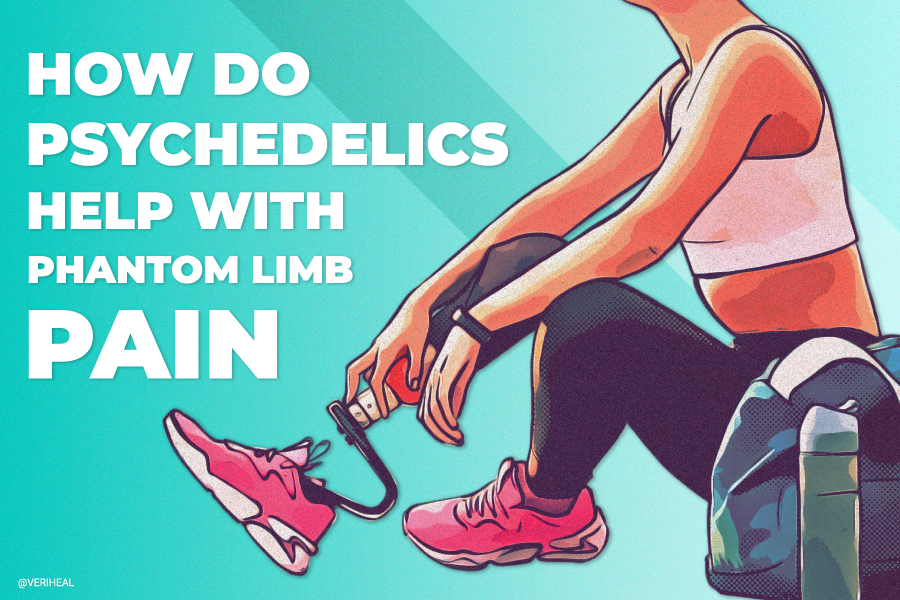As if losing a limb is not hard enough, experiencing pain in the part of the limb that is no longer there acts as a constant reminder of what has been lost on top of the actual pain. Phantom limb pain (PLP) plagues an estimated 8 out of 10 people who have lost a limb, and the pain has been described as “shooting, stabbing, cramping, pins and needles, crushing, throbbing or burning.”
While there are some existing treatments for managing phantom limb pain, many are still seeking relief. Fortunately, a recent study found amazing results for psychedelics as a means of dealing with phantom limb pain.
The Promising Case of Albert Lin
A case study published in Neurocase found that the combination of psilocybin and mirror visual feedback (MVF) was able to provide relief for phantom limb pain. The report’s co-author, Albert Lin, is not only a research scientist at the University of California San Diego (UCSD) but also a National Geographic explorer, television host, and the patient in the study. Among the researchers was Vilayanur Ramachandran, who was responsible for inventing MVF during the 1990s.
Lin’s leg was amputated, “resulting in phantom-limb pain (PLP),” which made him ideal for this kind of experimental research geared toward finding relief for the many who experience PLP. The researchers confirmed that high doses of psilocybin (the psychedelic compound) and MVF resulted in the alleviation of sharp phantom pain in his missing limb. However, the researchers are not entirely sure of the mechanisms behind the results.
Lin described his experience by stating that his pain “wasn’t subtle” and that it was “like being in the heart of a trauma all of the time. It was all consuming, but coming from a part of the body that literally no longer existed. I was desperate. I felt like I was gasping for air in a pool, looking for relief.” However, after the psilocybin and MVF therapy, Lin stated:
“The pain was gone. I did handstands. It was a profoundly spiritual moment. My mind had a map of my body and it was experiencing severe feedback issues, but it had to let go of that map through a sort of ‘state of ego death’ in which the psilocybin allowed the mind to reject the old map and create a new one. Now, I occasionally have a jolt of pain, but it’s mostly gone.”
One of the researchers’ theories is that psychedelics cause the activation of the 5-HT2A serotonin receptor, which assists the brain in making new connections. They wrote, “It is possible that the psychoactive effects of psilocybin are accompanied by an increased state of cross-modal functional connection and neuroplasticity via serotonergic effect…If this is the case, then the psilocybin might both make the brain more receptive to mirror therapy and make the pain reduction last longer or even disappear.” Essentially, they theorize that the combination of psychedelics and MVF worked together to rewire Lin’s mind.
Now, Lin is able to enjoy physical activities such as swimming and hiking with the help of psychedelics to keep his PLP at bay (along with the use of his prosthetic leg). Two years after their research was published, researchers from the same university further investigated the link between psychedelics and chronic pain by compiling the existing research available on psychedelics (mainly psilocybin and LSD) for chronic pain.
What Is Mirror Visual Feedback?
Mirror visual feedback (MVF) is a type of therapy used for pain or disability and is designed to affect the patient more on one side of the body than the other. While a mirror is positioned in front of the body, the patient is directed to focus on the side of the body with the intact limb. The patient then makes movement with the intact limb to imagine regaining control over their missing limb. This artificial visual feedback allows the patient to “move” their missing limb and essentially release it from its painful position.
Rewiring the Brain With Psychedelics
Among the research collected by the second study from UCSD was a case study from 1967, in which five out of six patients found a significant reduction in PLP after having taken LSD. Another study from 1977 found that five out of seven of the participants also had significant improvement in their pain after taking LSD. This study also found that the use of LSD led to a 50% reduction in the use of typically addictive painkillers (such as opioids).
A pain physician from UCSD, Joel Castellanos, explains that “of all the chronic pain conditions, phantom-limb pain is one of the few that is pretty much a purely central pain phenomenon,” and that “the pain comes from a dissonance between the lack of input from the nerves within the area of the brain that represents the area that’s no longer there.” He goes on to state that psychedelics like psilocybin “bring the brain’s representation of the body back into alignment.”
The use of psychedelics for PLP is likely thanks to neuroplasticity, as they encourage our brain to adapt itself in a manner that allows the brain to fire in a healthier and more efficient manner. It should be noted that this adaptation is often referred to as a re-alignment or reset despite the fact that this is not actually what is happening in the entire brain. Instead, this re-alignment or reset refers specifically to ineffective or wasted efforts (such as firing signals to and from the part of the brain that represents the limb that is no longer there).
The Future of Psychedelics for Phantom Limb Pain
Psychedelics for phantom limb pain are clearly effective, especially when paired with therapy like MVF. However, the mechanisms behind the PLP improvement as a result of psychedelics need to be further explored. Whether the effectiveness of psychedelics for PLP lies in the fact that new connections can be made via the 5-HT2A serotonin receptor or the fact that psychedelics manipulate our neuroplastic processes to reset the brain, further research will find out.
UCSD researchers have received a grant of $1.3 million in order to further investigate the therapeutic potential of psilocybin as a means of treating phantom limb pain. This grant will be used to “fund the first randomized, placebo-controlled human clinical trial examining the safety and efficacy of psilocybin in patients suffering from chronic phantom limb pain.”
According to Dr. Timothy Furnish, the benefits of psychedelics for PLP extend beyond superficial pain relief:
“Most analgesic drugs are taken at least daily to treat the symptoms of chronic pain, but they do nothing to change the underlying pathology…Psilocybin has the potential to ‘reset’ altered cortical brain circuits associated with certain chronic pain conditions. This reset could result in a drug that works on an extended basis (days or weeks) or perhaps even constitutes a ‘cure.’ The signals for such a change are strongest for pain conditions involving significant reorganization of pain circuits in the brain. We have already seen evidence that psilocybin may reset these circuits.”
Author, Share & Comments








